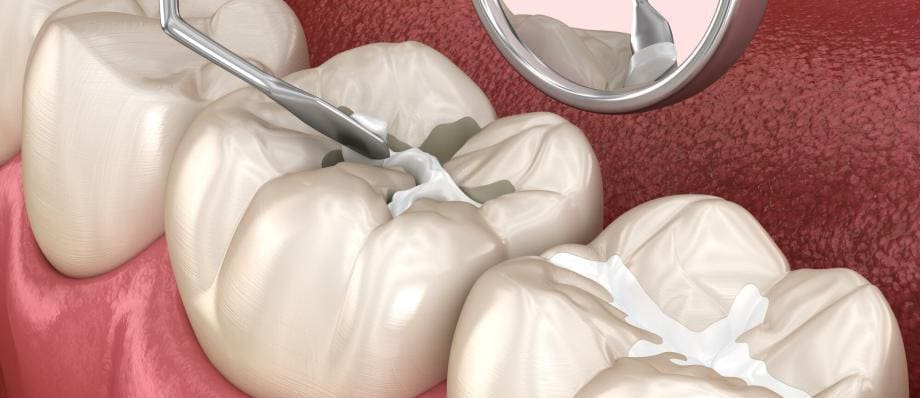Dental caries (tooth decay) is a common problem that affects millions of people worldwide. One of the most effective ways to prevent tooth decay is to use fissure sealant.
Fissure sealants are a type of dental treatment that can help protect teeth from developing cavities. In this article, we will discuss what fissure sealant is, how it works, its benefits, and some important considerations to keep in mind.
Table of Contents
ToggleWhat is Fissure Sealant?
Fissure sealant is a thin layer of plastic that is applied to the chewing surfaces of the teeth. It is used to fill the tiny grooves and fissures that are present on the teeth, especially the molars and premolars.
These grooves and fissures can be difficult to clean and are prone to developing cavities and tooth decay. By filling them with a sealant, the tooth surface is made smoother and easier to clean, reducing the risk of cavities.
How does Fissure Sealant Work?
Fissure sealant works by forming a physical barrier between the tooth surface and the bacteria that cause tooth decay. The sealant material is applied to the tooth surface in liquid form and then hardened using a special light. Once the sealant is hardened, it forms a smooth surface that is resistant to bacteria and acids.
Benefits of Fissure Sealant
There are several benefits of using fissure sealant:
- Prevents Tooth Decay
- Easy to Apply
- Long-Lasting
- Safe
Prevents Tooth Decay
Fissure sealants are highly effective at preventing tooth decay, especially in children. By sealing the tiny grooves and fissures on the teeth, the risk of developing cavities is greatly reduced.
Easy to Apply
Applying fissure sealants is a quick and painless procedure that can be done in a single visit to the dentist or the pediatric dentist. The tooth surface is cleaned and prepared, and then the sealant is applied and hardened using a special light.
Long-Lasting
Fissure sealants can last for several years with proper care and maintenance. They are a cost-effective way to prevent tooth decay and can save money on future dental treatments.
Safe
Fissure sealant is a safe and non-invasive dental treatment. The sealant material is BPA-free and does not cause any harm to the teeth or gums.
Considerations
While fissure sealant is an effective way to prevent tooth decay, there are some important considerations to keep in mind:
- Not Suitable for Everyone
- Not a Substitute for Good Oral Hygiene
- May Need to be Reapplied
Not Suitable for Everyone
Fissure sealants are most effective when applied to the teeth of children and teenagers. However, they may not be suitable for everyone. Individuals with deep cavities or other dental problems may require other treatments.
Not a Substitute for Good Oral Hygiene
Fissure sealant is not a substitute for good oral hygiene. Regular brushing, flossing, and dental check-ups are still essential for maintaining good dental health.
May Need to be Reapplied
Fissure sealant can last for several years, but it may need to be reapplied over time. Your dentist will monitor the condition of your sealants and recommend when they need to be replaced.
Types of Fissure Sealant
There are two main types of fissure sealant:
- Resin-based
- Glass-ionomer-based
Resin-based
They are the most commonly used and are made from a dental composite material that hardens when exposed to a special light.
Glass-ionomer-based
This type of sealants are made from a combination of glass particles and an organic acid and are known for their ability to release fluoride, which helps to further protect teeth from decay.
When to Get Fissure Sealants?
Fissure sealant is most commonly used on the molars and premolars of children and teenagers, as these teeth are the most susceptible to decay. However, it can also be used on the teeth of adults who have deep grooves and fissures that are difficult to clean.
The best time to get fissure sealant is soon after the permanent molars have erupted, which typically occurs between the ages of 6 and 12. Applying sealants soon after the teeth have erupted can help to protect them during the most vulnerable period of their development.
How Fissure Sealant is Applied?
Applying fissure sealant is a quick and painless procedure that can be done in a single visit to the dentist.
The tooth surface is first cleaned and prepared using a special gel or solution. The sealant material is then applied to the tooth surface in liquid form and spread into the grooves and fissures using a brush.
Once the sealant has been applied, it is hardened using a special light. This process only takes a few seconds and does not cause any discomfort. Once the sealant has hardened, the tooth surface is smoothed and polished to ensure that it does not interfere with the patient’s bite.
Caring for Fissure Sealant
Caring for fissure sealant is easy and straightforward. Patients should continue to brush and floss regularly, paying special attention to the sealed teeth. They should also avoid biting down on hard objects, such as ice or hard candy, as this can cause the sealant to crack or chip.
Regular dental check-ups are also important for maintaining the integrity of the sealants. Your dentist will monitor the condition of your sealants and recommend when they need to be replaced.
Conclusion
Fissure sealants are a safe and effective way to prevent tooth decay, especially in children and teenagers. They are easy to apply, long-lasting, and can save money on future dental treatments. While fissure sealants are not a substitute for good oral hygiene, they can provide an extra layer of protection for teeth that are prone to developing cavities. If you are interested in getting fissure sealants, talk to your dentist to see if they are right for you.

